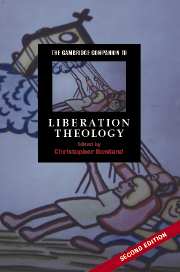Book contents
- Frontmatter
- Introduction: the theology of liberation
- Part I Contemporary Liberation Theology
- 1 The task and content of liberation theology
- 2 ‘Action is the life of all’: the praxis-based epistemology of liberation theology
- 3 Liberation theology in Asia
- 4 Black theology
- 5 Feminist theology: a critical theology of liberation
- 6 Demythologising liberation theology: reflections on power, poverty and sexuality
- Part II Aspects of Liberation Theology
- Part III Analysis and Criticism
- Epilogue: the future of liberation theology
- Select bibliography
- Index
- Series list
3 - Liberation theology in Asia
from Part I - Contemporary Liberation Theology
Published online by Cambridge University Press: 28 January 2008
- Frontmatter
- Introduction: the theology of liberation
- Part I Contemporary Liberation Theology
- 1 The task and content of liberation theology
- 2 ‘Action is the life of all’: the praxis-based epistemology of liberation theology
- 3 Liberation theology in Asia
- 4 Black theology
- 5 Feminist theology: a critical theology of liberation
- 6 Demythologising liberation theology: reflections on power, poverty and sexuality
- Part II Aspects of Liberation Theology
- Part III Analysis and Criticism
- Epilogue: the future of liberation theology
- Select bibliography
- Index
- Series list
Summary
The Asian context
Liberation theology differs from other theologies in that it starts with ananalysis of the context, as it wants to respond to the cries of the people arisingfrom it. As contextual theology we can distinguish it by regions - Latin American,African, Asian, European - and by social groups such as the poor, women, blacks,Dalits, indigenous peoples. However, none of these social or geographicalidentities can be understood in isolation. Contexts and identities are multipleand overlapping. The realities of class, caste, patriarchy and ethnicity, and oflocal, regional and global economy are intertwined. A Dalit girl working in afactory in an export-processing zone in India is exploited as an underpaid worker- like other workers around the globe - and suffers from a lack of protection bytrade-union rights, while as a woman she suffers from male domination and violence- as other women do - whereas she shares her plight as an 'untouchable' sufferingfrom caste oppression with other outcastes, male and female, in India.
What is specific about Asia, especially in contrast with Latin America, is thereligio-cultural context. The overwhelming majority of the poor and oppressed inAsia are non-Christians, many of whom adhere to a wide variety of popularreligious traditions which are more or less connected with the traditions of thegreat religions which have shaped dominant Asian cultures. Yet within Asia thereare again tremendous differences. Latin America is, compared to Asia, a relativelyhomogeneous continent in terms of history, language, economic and politicaldevelopments. Asia has to be subdivided into various regions with differentcultural, religious, political and economic histories.
- Type
- Chapter
- Information
- The Cambridge Companion to Liberation Theology , pp. 55 - 78Publisher: Cambridge University PressPrint publication year: 2007
- 5
- Cited by



